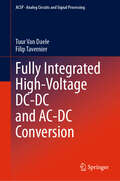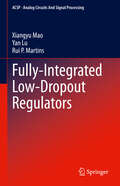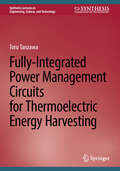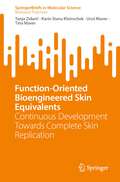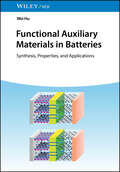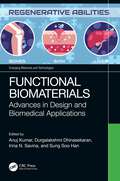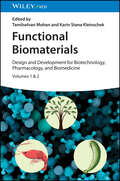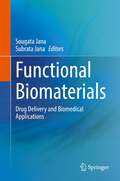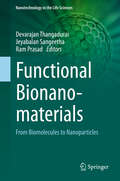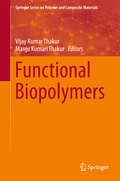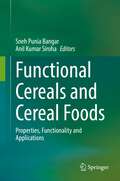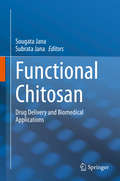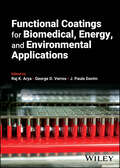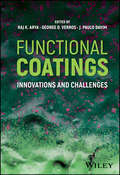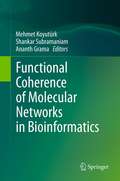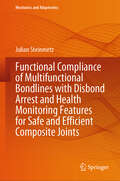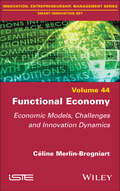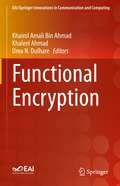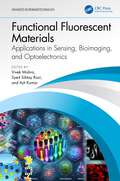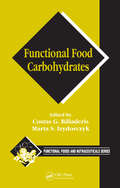- Table View
- List View
Fullerenes: Nanochemistry, Nanomagnetism, Nanomedicine, Nanophotonics
by Elena ShekaAt the interface between chemistry, biology, and physics, fullerenes were one of the first objects to be dissected, scanned, and studied by the modern multi-specialty biotech community and are currently thriving in both research and practical application. Other members of the sp2 nanocarbon family, such as nanotubes and graphene, are currently bein
Fully Homomorphic Encryption in Real World Applications (Computer Architecture and Design Methodologies)
by Ayantika Chatterjee Khin Mi AungThis book explores the latest developments in fully homomorphic encryption (FHE), an effective means of performing arbitrary operations on encrypted data before storing it in the ‘cloud’. The book begins by addressing perennial problems like sorting and searching through FHE data, followed by a detailed discussion of the basic components of any algorithm and adapting them to handle FHE data. In turn, the book focuses on algorithms in both non-recursive and recursive versions and discusses their realizations and challenges while operating in the FHE domain on existing unencrypted processors. It highlights potential complications and proposes solutions for encrypted database design with complex queries, including the basic design details of an encrypted processor architecture to support FHE operations in real-world applications.
Fully Integrated High-Voltage DC-DC and AC-DC Conversion (Analog Circuits and Signal Processing)
by Filip Tavernier Tuur Van DaeleThis book reveals to readers how to harness high-voltage power for everyday electronics. The authors detail the transformation of up to 400 V—from household outlets and electric vehicle batteries—into the low voltage required for devices like smart home systems and LED lights. This concise guide delves into the cutting-edge integration of DC-DC and AC-DC converters onto a single microchip using a high-voltage switched-capacitor approach. Explore expert insights on topology, circuit design, and layout techniques that are shaping the future of power management.
Fully Integrated Switched-Capacitor PMU for IoT Nodes: Analysis and Design (Synthesis Lectures on Engineering, Science, and Technology)
by Nuno Paulino Ricardo Madeira João Pedro OliveiraThis book provides a step-by-step methodology and system design that can be used to design a fully integrated PMU using SC DC-DC converters, for any CMOS technology. The authors discuss trade-offs between power density and efficiency of the methodology for the 130 nm CMOS technology, and how to implement it on other CMOS technologies. The book describes the state-of-the-art of fully or near-fully integrated SC DC-DC converters with multiple conversion ratios and the techniques used to enhance the overall performance of these converters. Coverage includes the trade-off between the number of conversion ratios and overall extracted efficiency from a supercapacitor, as well as the sizing of the converter cells according to the desired output power and maximum clock frequency. The authors also describe in detail the design of the fundamental blocks for the converter operation, which includes a secondary control loop using capacitance modulation by sensing the clock frequency.
Fully-Integrated Low-Dropout Regulators (Analog Circuits and Signal Processing)
by Yan Lu Xiangyu Mao Rui P. MartinsThis book discusses in detail the key specifications of fully integrated low-dropout regulators (LDOs). It covers the various LDO architectures, including the classic analog architectures and the state-of-the-art digital and switching control methods. The design insight and comparison are discussed according to the key performance index. Readers will be enabled to find a suitable architecture when designing a fully integrated LDO.
Fully-Integrated Power Management Circuits for Thermoelectric Energy Harvesting (Synthesis Lectures on Engineering, Science, and Technology)
by Toru TanzawaThis book describes fully-integrated power management circuits for thermoelectric energy harvesting. Readers will learn about the applications, system design fundamentals, designs of building blocks, maximum power point tracking techniques, and design of battery chargers. The book covers the following key topics: 1) minimizing the cost of a thermoelectric generator (TEG) by considering the maximum open circuit voltage of TEG and the dependence of the power conversion efficiency of the converter on the input voltage, 2) controlling the input voltage of the converter system to ensure it remains higher than the minimum operating voltage, 3) designing a charge pump operating in the sub-threshold region, considering factors such as clock frequency, stage capacitor size, rectifying device size, and the number of stages, 4) implementing maximum power point tracking techniques with a small circuit area, and 5) designing a fully integrated battery charger. Readers will gain a comprehensive understanding of these concepts and their practical applications.
Function-Oriented Bioengineered Skin Equivalents: Continuous Development Towards Complete Skin Replication (SpringerBriefs in Molecular Science)
by Tina Maver Uroš Maver Karin Stana Kleinschek Tanja ZidaričThe book Function-oriented bioengineered skin equivalents - continuous development towards complete skin replication aims to provide potential readers with a comprehensive summary of the available information on various in vitro skin models, from historical background to different modeling approaches and their applications. Particular emphasis is placed on presenting the current technological components available for the development of engineered skin equivalents by summarizing advances in cell cultivation, materials science, and bioengineering. Using examples of the current-state-of-art, we describe the advantages, limitations, and challenges of developing in vitro skin models for successful use in clinical applications and skin-related research.
Functional Auxiliary Materials in Batteries: Synthesis, Properties, and Applications
by Wei HuComprehensive reference exploring innovative auxiliary materials as a variety of battery components to enhance battery performance, safety, and longevity Functional Auxiliary Materials in Batteries: Synthesis, Properties, and Applications overviews the latest research on the applications of organic functional materials and low-dimensional structural materials as functional auxiliary materials in batteries. The book introduces the properties and preparation methods of these materials, summarizes the application mechanisms and conclusions, and puts forward novel insights and prospects towards more sustainable and environmentally friendly battery technologies. The first five chapters of this book expand around the application of organic functional materials in batteries, including separators, binders, electrolytes, and functional additives. The last two chapters of this book expand around the application of low-dimensional structural materials in batteries, including conductive agents and functional additives. Functional Auxiliary Materials in Batteries includes information on: Film forming, flame retardant, high voltage, and overcharge protection additives Adjusting factors in biopolymer materials such as molecular structure, composition, and morphology to precisely regulate and optimize battery performance Ionic liquids and single-ion conductors as a more secure and widely usable alternative to traditional organic electrolytes Self-healing materials, covering their positive effects on energy density, cost reduction, safety, and sustainability and their challenges including complexity and material compatibility Carbon-based materials that mitigate polysulfide shuttle effects and extend cycle life Functional Auxiliary Materials in Batteries is an essential reference for new researchers seeking to quickly understand the progress of research in related fields. The book is also valuable for senior researchers seeking inspiration for innovation.
Functional Biomaterials: Advances in Design and Biomedical Applications (Emerging Materials and Technologies)
by Anuj KumarWith the emergence of additive manufacturing, mass customization of biomaterials for complex tissue regeneration and targeted drug delivery applications is possible. This book emphasizes the fundamental concepts of biomaterials science, their structure–property relationships and processing methods, and biological responses in biomedical engineering. It focuses on recent advancements in biomedical applications, such as tissue engineering, wound healing, drug delivery, cancer treatments, bioimaging, and theranostics. This book Discusses design chemistry, modification, and processing of biomaterials. Describes the efficacy of biomaterials at various scales for biological response and drug delivery. Demonstrates technological advances from conventional to additive manufacturing. Covers future of biofabrication and customized medical devices. This volume serves as a go-to reference on functional biomaterials and is ideal for multi-disciplinary communities such as students and research professionals in materials science, biomedical engineering, healthcare, and medical fields.
Functional Biomaterials: Design and Development for Biotechnology, Pharmacology, and Biomedicine, 2 Volumes
by Tamilselvan MohanA succinct handbook explaining interdisciplinary processing, methods, and applications of bio-based materials This book merges the two most important trends in biomaterials: functionalization and renewable chemistry. It covers a variety of biopolymers and various approaches for the transformation of these biopolymers into functional units. Sample topics covered by the two well-qualified authors include: Fundamental knowledge of biopolymers–natural ones, such as cellulose and other polysaccharides, and synthetic ones, such as polyethylene The origin, classifications, chemical nature, and isolation methods of specific biopolymers The different classical and modern approaches for the transformation of biopolymers into different shapes, ranging from thin films (model surfaces), to nanoparticles, to nanofibers, all the way to 3D scaffolds The morphology, structure, shape, thermal, electrical, and surface properties of biomaterialsThis all-inclusive reference guide, which covers fundamentals, methods, and applications alike, is a key resource for both students and practicing scientists involved in programs of study or disciplines that intersect with the field of biomaterials.
Functional Biomaterials: Drug Delivery and Biomedical Applications
by Sougata Jana Subrata JanaThis book explores in depth a wide range of functional biomaterials-based systems for drug, gene delivery, and biomedical aspects. The chapters cover newer technologies such as polymeric micelle, pH-responsive biomaterials, stimuli-responsive hydrogels, silk fibroin, inorganic biomaterials, synthetic biomaterials, 3D printed biomaterials, metallic biomaterials, ceramic and hybrid biomaterials. It also describes the theranostic approaches for cancer therapy, the biomaterials-based nanofibers scaffolds in tissue engineering, as well as the strategies applications of metallic biomaterials for the medical and dental prosthetic field. This newer and updated approach will be attractive for biomedical engineering students working on materials science in the development of novel drug delivery strategies. The book will be an important reference for researchers and professionals working on biomaterial research in the pharmaceutical and medical fields.
Functional Bionanomaterials: From Biomolecules to Nanoparticles (Nanotechnology in the Life Sciences)
by Jeyabalan Sangeetha Ram Prasad Devarajan ThangaduraiThis book focuses on the application of nanotechnology in medicine and drug delivery, including diagnosis and therapy. Nanomedicine can contribute to the development of a personalized medicine both for diagnosis and therapy. By interacting with biological molecules at nanoscale level, nanotechnology opens up an immense field of research and applications. Interactions between artificial molecular assemblies or nanodevices and biomolecules can be understood both in the extracellular medium and inside human cells. Operating at nanoscale allows exploitation of physical properties different from those observed at microscale, such as the volume to surface area ratio.A number of clinical applications of nanobiotechnology, such as disease diagnosis, target-specific drug delivery, and molecular imaging are being investigated. Some promising new products are also undergoing clinical trials. Such advanced applications of this approach to biological systems will undoubtedly transform the foundations of diagnosis, treatment, and prevention of disease in the future.Nanomedicine sales reached $16 billion in 2015, with a minimum of $3.8 billion in nanotechnology R&D being invested each year. Global funding for emerging nanotechnology increased by 45% per year in recent years, with product sales exceeding $1 trillion in 2013. As the nanomedicine industry continues to grow, it is expected to have a significant impact on the global economy.This book provides clear, colorful and simple illustrations, tables, and case studies to clearly convey the content to a general audience and reader. This book also discusses the development of nanobiomaterials from biogenic (biological sources) systems for healthcare and disease therapies. This book, therefore, is useful for researchers and academicians in the fields of nanotechnology, medicine, nano-biotechnology and pharmacology.
Functional Biopolymers
by Vijay Kumar Thakur Manju Kumari ThakurThis book presents the synthesis, processing and application of selected functional biopolymers as new advanced materials. It reviews theoretical advances as well as experimental results, opening new avenues for researchers in the field of polymers and sustainable materials. The book covers various aspects, including the structural analysis of functional biopolymers based materials; functional biopolymer blends; films, fibers, foams, composites and different advanced applications. A special emphasis is on cellulose-based functional polymers, but other types of functional biopolymers (e. g. from chitosan, starch, or plant oils) are also described.
Functional Brain-Heart Interplay: From Physiology to Advanced Methodology of Signal Processing and Modeling
by Gaetano Valenza Vincenzo CatramboneThis monograph offers a cross-system exchange and cross-modality investigation into brain-heart interplay. Brain-Heart Interplay (BHI) is a highly interdisciplinary scientific topic, which spreads from the physiology of the Central/Autonomous Nervous Systems, especially Central Autonomic Network, to advanced signal processing and modeling for its activity quantification. Motivated by clinical evidence and supported by recent findings in neurophysiology, this monograph first explores the definition of basic Brain-Heart Interplay quantifiers, and then moves onto advanced methods for the assessment of health and disease states. Non-invasive use of brain monitoring techniques, including electroencephalogram and function Magnetic Resonance Imaging, will be described together with heartbeat dynamics monitoring through pulseoximeter and ECG signals. The audience of this book comprises especially of biomedical engineers and medical doctors with expertise in statistics and/or signal processing. Researchers in the fields of cardiology, neurology, psychiatry, and neuroscience in general may be interested as well.
Functional Carbohydrates: Development, Characterization, and Biomanufacture
by Jian Chen Yang Zhu Song Liu"Functional carbohydrates" is the term used to describe those carbohydrates that play an important role in strengthening immunity, decreasing the level of blood-lipid, and regulating the intestinal flora of humans, beyond those simply used as the energy-supplying materials. To date functional carbohydrates mainly cover dietary fiber, functional polysaccharides, functional oligosaccharides, sugar alcohols, and other functional monosaccharides. Functional Carbohydrates: Development, Characterization, and Biomanufacture facilitates tracking the important progresses in functional carbohydrates. This book addresses the history and recent developments of a selected number of important functional carbohydrates and it introduces the source, properties, and applications of a number of functional carbohydrates. It describes in detail the biomanufacture of these carbohydrates based on fermentation or enzyme catalysis, including the strain screening and improvement, optimization of fermentation process, and product downstream processing.
Functional Cereals and Cereal Foods: Properties, Functionality and Applications
by Anil Kumar Siroha Sneh Punia BangarIn recent years, consumers are concentrating more on the health benefits of food in order to preserve a healthy lifestyle and therefore becoming more aware of the relationship between diet and disease. This has resulted in a gradual shift from animal-derived to plant-based meals. Functional foods have turned into one of the rapidly expanding areas of the food industry due to the increasing awareness of consumers working to prevent lethal diseases like cancer, diabetes mellitus and cardiovascular disease. Functional foods are seen as the food or food components that manifest efficiency in protecting from diseases and attaining a healthier lifestyle by administering additional benefits on human physiology and metabolic functions apart from basic nutritional requirements of the body. Cereals hold a prominent place in this new market. Cereals and cereal foods are important energy sources and many phytochemicals such as dietary fiber, resistant starch, vitamins, minerals, lignans, phytic acid and phenolic compounds that provide a variety of health benefits. Eating functional cereal foods is an easy method to increase nutrients associated with whole grains without changing eating habits. Functional Cereals and Cereal Foods: Properties, Functionality and Applications comprehensively covers the Chemistry and nutritional composition of functional cereals components, their functionality and therapeutic significance, current innovations and functional approaches in improving attributes and biofortification and quality improvement of cereal products. The different types of functional cereals and their unlimited opportunities for the production of functional foods are covered in full, including gluten-free products and all the newest cereal processing technologies. For researchers in search of a fully up-to-date look at functional cereal foods and technologies and their important place on the current market, this text provides a timely and comprehensive overview.
Functional Chitosan: Drug Delivery and Biomedical Applications
by Sougata Jana Subrata JanaThanks to their unique properties, chitosan and chitosan-based materials have numerous applications in the field of biomedicine, especially in drug delivery. This book examines biomedical applications of functional chitosan, exploring the various functions and applications in the development of chitosan-based biomaterials. It also describes the chemical structure of chitosan and discusses the relationship between their structure and functions, providing a theoretical basis for the design of biomaterials. Lastly, it reviews chemically modified and composite materials of chitin and chitosan derivatives for biomedical applications, such as tissue engineering, nanomedicine, drug delivery, and gene delivery.
Functional Coatings for Biomedical, Energy, and Environmental Applications
by J. Paulo Davim Raj K. Arya George D. VerrosUnderstand functional coatings and their role in three key industries of the future Functional coatings play a huge range of roles in industries from automotive to aerospace to electronic and beyond. They offer protection, performance enhancement, corrosion resistance, self-cleaning properties, and more. Recent developments in the field have allowed for ever more precise optimization of functional coatings, with the result that demand for these key tools is only likely to increase. Functional Coatings for Biomedical, Energy, and Environmental Applications offers a comprehensive overview of these coatings and their applications in three explosively productive industries. A team of expert contributors provides chapters analyzing the latest developments in this growing area of production, with a particular focus on the dynamic relationship between functional coatings and their many applications. The result is an interdisciplinary text which will serve as an essential resource for researchers and industry professionals worldwide. Readers will also find: Analysis of functional coatings for dental implants, pool boilers, solar cells, and many more Detailed discussion of coating properties including superhydrophobicity, self-cleaning, controlled drug release, and more Key contributions to the great environmental challenges of the twenty-first century This book is a must-own for researchers in chemistry, engineering, energy, materials science, and more, as well as for industry professionals working with coating and other aspects of research and development in biomedical, energy, or environmental industries.
Functional Coatings: Innovations and Challenges
by J. Paulo Davim Raj K. Arya George D. VerrosFUNCTIONAL COATINGS A must-own resource for understanding functional coatings and their revolutionary potential Functional coatings are those which provide not only the protection and performance enhancement of a conventional coating, but also offer additional properties tailored to meet the specific requirements of a given industry or application. They have applications in a huge range of sectors, including automotive, aerospace, healthcare, energy, and more. Coatings with properties like fire retardancy, antimicrobial properties, or controlled drug release have the potential to revolutionize entire industries. Functional Coatings offers a comprehensive resource for engineers and researchers looking to understand these coatings and the opportunities they provide. Beginning with an overview of the subject’s foundations and industrial significance, the book analyzes numerous coating methods and their properties, with a particular focus on anticorrosion coatings. The result is an indispensable resource for professionals in virtually any technological industry looking to understand the benefits of a cutting-edge toolkit. Functional Coatings readers will also find: Coverage of synthesis, durability, reproducibility, cost-effectiveness, specialized surface morphology, and environmental friendliness of each coating Detailed discussion of antimicrobial coatings, fire-retardant coatings, self-healing coatings, nanopowder coatings, coatings for marine applications, and many more Applications of additives, machine learning, and sophisticated characterizations, etc. as per industry requirements Functional Coatings is ideal for researchers, engineers, and industry professionals working with any area of technology where coatings have purchase.
Functional Coherence of Molecular Networks in Bioinformatics
by Ananth Grama Mehmet Koyutürk Shankar SubramaniamMolecular networks provide descriptions of the organization of various biological processes, including cellular signaling, metabolism, and genetic regulation. Knowledge on molecular networks is commonly used for systems level analysis of biological function; research and method development in this area has grown tremendously in the past few years. This book will provide a detailed review of existing knowledge on the functional characterization of biological networks. In 15 chapters authored by an international group of prolific systems biology and bioinformatics researchers, it will organize, conceptualize, and summarize the existing core of research results and computational methods on understanding biological function from a network perspective.
Functional Compliance of Multifunctional Bondlines with Disbond Arrest and Health Monitoring Features for Safe and Efficient Composite Joints (Mechanics and Adaptronics)
by Julian SteinmetzSafe and efficient joints are key for improving the structural efficiency of composite aircraft. Therefore, this thesis investigates the potential of multifunctional bondlines, combining structural bonding, disbond arrest features, and structural health monitoring. The central research question is how to achieve a functionally compliant design. This means ensuring disturbances between these functions do not eliminate their benefits regarding the objective of safe and efficient joints. The approach is adding discrete multifunctional disbond arrest features, functionally integrating disbond arrest and sensor functions, to epoxy bondlines. Experimental results indicate some major challenges such as a stiffness conflict for the integrated functions. Nevertheless, securing the epoxy bondline without disturbing its static strength proves successful in the end. In addition, the thesis provides some new insights regarding the functional compliance concept. For example, it strongly suggests considering temporal aspects, such as transient material properties.
Functional Economy: Economic Models, Challenges and Innovation Dynamics (ISTE Invoiced)
by Céline Merlin-BrogniartFunctional Economy is a concept that is often associated with ecological transition and sustainable development. It prioritizes the use of a service or good rather than its sale, and tends to encourage cooperation. This model supports the transition to a more ecological and equitable economic and social environment. This book presents the different approaches to the Functional Economy and the ways in which the various players (companies, public institutions and citizens) are adopting and adapting them through innovation. Depending on their degree of sustainability and their scope, these innovations can have major economic, social and environmental impacts. Particularly at the local territorial level, those involved in innovation need to be supported as closely as possible if they are to overcome the hurdles they face and reap the rewards of the transformations brought about by this socio economic model, which is built around functionality.
Functional Encryption (EAI/Springer Innovations in Communication and Computing)
by Khaleel Ahmad Uma N. Dulhare Khairol Amali Bin AhmadThis book provides awareness of methods used for functional encryption in the academic and professional communities. The book covers functional encryption algorithms and its modern applications in developing secure systems via entity authentication, message authentication, software security, cyber security, hardware security, Internet of Thing (IoT), cloud security, smart card technology, CAPTCHA, digital signature, and digital watermarking. This book is organized into fifteen chapters; topics include foundations of functional encryption, impact of group theory in cryptosystems, elliptic curve cryptography, XTR algorithm, pairing based cryptography, NTRU algorithms, ring units, cocks IBE schemes, Boneh-Franklin IBE, Sakai-Kasahara IBE, hierarchical identity based encryption, attribute based Encryption, extensions of IBE and related primitives, and digital signatures.Explains the latest functional encryption algorithms in a simple way with examples;Includes applications of functional encryption in information security, application security, and network security;Relevant to academics, research scholars, software developers, etc.
Functional Fluorescent Materials: Applications in Sensing, Bioimaging, and Optoelectronics (Advances in Bionanotechnology)
by Vivek Mishra Ajit Kumar Syed Sibtay RaziFunctional Fluorescent Materials: Applications in Sensing, Bioimaging, and Optoelectronics explains functional molecular probes (organic/inorganic materials, polymers, nanomaterials), with a focus on those that represent spectroscopic properties with detection of different analytes and specific roles in molecular recognition and their applications. It broadly covers molecular recognition to applications of fluorescence reporters, starting from optoelectronic properties of materials, detection of heavy metals, through biological macromolecules, and further to a living cell, tissue imaging, and theranostics.Features:• Covers different aspects of fluorescence spectroscopy ranging from chemical, physical, and biological aspects along with optoelectronic properties, mechanisms, and applications. • Describes all types of chemical and functionalized fluorescent nanomaterials. • Provides additional information on different kinds of fluorescence reporters.• Explains the concept of fluorescence spectroscopy and its role in human health care. • Discusses changes in static and dynamic properties of fluorescent probes and molecular recognitions.This book is aimed at graduate students and researchers in materials, chemical engineering, and engineering physics.
Functional Food Carbohydrates
by Costas G. Biliaderis Marta S. IzydorczykFunctional Food Carbohydrates presents comprehensive coverage of a broad range of physiologically active carbohydrate compounds and their roles in the promotion of health and the prevention of disease. It provides the most up-to-date information available on the chemistry, physical properties, processing effects, production, and physiological function of these food constituents. The volume discusses the specific classes of carbohydrates in foods that seem to exert health-enhancing effects based on clinical and/or epidemiological studies and reviews the physiological and metabolic roles that different carbohydrates have in disease prevention and management, focusing on chronic diseases.


